
A | B | C | D | E | F | G | H | CH | I | J | K | L | M | N | O | P | Q | R | S | T | U | V | W | X | Y | Z | 0 | 1 | 2 | 3 | 4 | 5 | 6 | 7 | 8 | 9
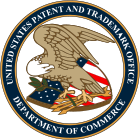 Seal of the U.S. Patent and Trademark Office | |
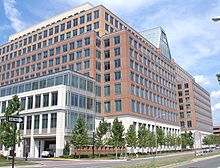 The James Madison building on the campus of the United States Patent and Trademark Office headquarters in Alexandria. This is the largest building on the campus. | |
| Agency overview | |
|---|---|
| Formed | July 4, 1836[1][2] Washington, D.C., U.S. |
| Headquarters | Alexandria, Virginia, U.S. 38°48′05″N 77°03′50″W / 38.801499°N 77.063835°W |
| Employees | 13,103 (as of September 30, 2022)[3]: 20 |
| Agency executives |
|
| Parent agency | United States Department of Commerce |
| Website | www |
| United States patent law |
|---|
| Legislation |
| Types of patent claims |
| Procedures |
| Other topics |

The United States Patent and Trademark Office (USPTO) is an agency in the U.S. Department of Commerce that serves as the national patent office and trademark registration authority for the United States. The USPTO's headquarters are in Alexandria, Virginia, after a 2005 move from the Crystal City area of neighboring Arlington, Virginia.
The USPTO is "unique among federal agencies because it operates solely on fees collected by its users, and not on taxpayer dollars".[7] Its "operating structure is like a business in that it receives requests for services—applications for patents and trademark registrations—and charges fees projected to cover the cost of performing the services provide".[7][8]
The Office is headed by the Under Secretary of Commerce for Intellectual Property and Director of the United States Patent and Trademark Office, currently held by Kathi Vidal as of April 19, 2022. Andrei Iancu was the former director of the USPTO until he left office on January 20, 2021.
The USPTO cooperates with the European Patent Office (EPO) and the Japan Patent Office (JPO) as one of the Trilateral Patent Offices. The USPTO is also a Receiving Office, an International Searching Authority and an International Preliminary Examination Authority for international patent applications filed in accordance with the Patent Cooperation Treaty.
Mission
The legal basis for the United States patent system is the Copyright Clause in Section 8 of Article I of the U.S. Constitution, which gives Congress the power to grant patents and copyrights on a national basis. Trademark law, on the other hand, is considered to be authorized by the Commerce Clause.[9]
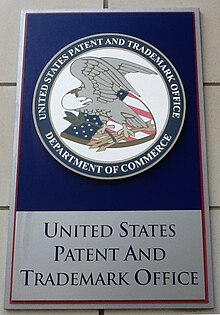
The Congress shall have Power ... To promote the Progress of Science and useful Arts, by securing for limited Times to Authors and Inventors the exclusive Right to their respective Writings and Discoveries.
The USPTO maintains a permanent, interdisciplinary historical record of all U.S. patent applications in order to fulfill objectives outlined in the United States Constitution.[7] The PTO's mission is to promote "industrial and technological progress in the United States and strengthen the national economy" by:
- Administering the laws relating to patents and trademarks;
- Advising the Secretary of Commerce, the President of the United States, and the administration on patent, trademark, and copyright protection; and
- Providing advice on the trade-related aspects of intellectual property.
Structure
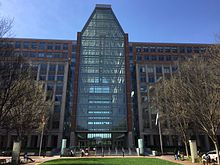
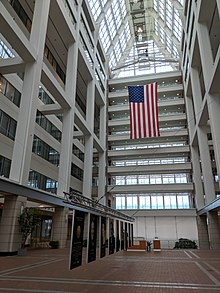
The USPTO is headquartered at the Alexandria Campus, consisting of 11 buildings in a city-like development surrounded by ground floor retail and high rise residential buildings between the Metro stations of King Street station (the main search building is two blocks due south of the King Street station) and Eisenhower Avenue station where the actual Alexandria Campus is located between Duke Street (on the North) to Eisenhower Avenue (on the South), and between John Carlyle Street (on the East) to Elizabeth Lane (on the West) in Alexandria, Virginia.[10][11][12] An additional building in Arlington, Virginia, was opened in 2009.
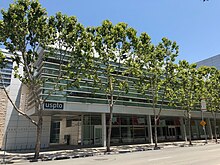
The USPTO was expected by 2014 to open its first ever satellite offices in Detroit, Dallas, Denver, and Silicon Valley to reduce backlog and reflect regional industrial strengths.[13] The first satellite office opened in Detroit on July 13, 2012.[14][15][16][17][18] In 2013, due to the budget sequestration, the satellite office for Silicon Valley, which is home to one of the nation's top patent-producing cities, was put on hold.[19] However, renovation and infrastructure updates continued after the sequestration, and the Silicon Valley location opened in the San Jose City Hall in 2015.[20]
As of September 30, 2009[update], the end of the U.S. government's fiscal year, the PTO had 9,716 employees, nearly all of whom are based at its five-building headquarters complex in Alexandria. Of those, 6,242 were patent examiners (almost all of whom were assigned to examine utility patents; only 99 were assigned to examine design patents) and 388 were trademark examining attorneys; the rest are support staff.[21] While the agency has noticeably grown in recent years, the rate of growth was far slower in fiscal 2009 than in the recent past; this is borne out by data from fiscal 2005 to the present:[21] As of the end of FY 2018, the USPTO was composed of 12,579 federal employees, including 8,185 patent examiners, 579 trademark examiners, and 3,815 other staff.[22]
| At end of FY | Employees | Patent examiners | Trademark examining attorneys | Patent Filings (Utility) | Trademark Filings | Patent Application Backlog |
|---|---|---|---|---|---|---|
| 2022 | 13,103[3]: 20 | 8,509[3]: 20 | 718[3]: 20 | 457,510[3]: 22 | 787,798[3]: 24 | |
| 2021 | 12,963[23]: 2,19,243 | 8,073[23]: 19,243 | 662[23]: 19,243 | 650,703[23]: 38 | 943,928[23]: 38,223 | |
| 2020[24] | 12,928 | 8,434 | 622 | 653,311[23]: 38,201 | 738,112[23]: 38,223 | |
| 2019[25] | 12,652 | 9,614 | 701 | 666,843[23]: 38,201 | 673,233[23]: 38,223 | |
| 2018[26] | 12,579 | 8,185 | 579 | 647,572[23]: 38,201 | 594,107[23]: 38 | |
| 2017[27] | 12,588 | 8,147 | 549 | 650,350[23]: 38,201 | 530,270[23]: 38 | 526,579 |
| 2016[28] | 12,725 | 8,351 | 570 | 650,411 | 530,270 | 537,655 |
| 2015[29] | 12,667 | 9,161 | 456 | 618,062[28] | 503,889[28] | 553,221[28] |
| 2014[30] | 12,450 | 9,302 | 429 | 618,457[28] | 455,017[28] | |
| 2013[31] | 11,773 | 8,051 | 409 | 601,464[28] | 433,654[28] | |
| 2012[32] | 11,531 | 7,935 | 386 | 565,406 | 415,026 | 608,283 |
| 2011[33] | 10,210 | 6,780 | 378 | 536,604 | 398,667 | |
| 2010[34] | 9,507 | 6,225 | 378 | 509,367 | 368,939 | 726,331 |
| 2009[35] | 9,716 | 6,243 | 388 | 485,500 | 352,051 | 750,596 |
| 2008[36] | 9,518 | 6,055 | 398 | 495,095 | 401,392 | 750,596 |
| 2007[37] | 8,913 | 5,477 | 404 | 467,243 | 394,368 | |
| 2006[38] | 4,779 | 413 | ||||
| 2005 | 4,177[38] | 357[38] | ||||
| 2004 | 3,681[38] | 286[38] | ||||
| 2003 | 3,579[38] | 256[38] | ||||
| 1998[39] | 5,300 | |||||
| 1996[40][41][42] | 189,979[41] | 200,640[42] | ||||
| 1995[43] | 221,304 | 175,307 | ||||
| 1994[44] | 186,126 | 155,376 | ||||
| 1993[44] | 174,553 | 139,735 | ||||
| 1992[44] | 172,539 | 125,237 | ||||
| 1986 | 120,988[41] | 69,253[42] | ||||
| 1976 | 101,807[41] | 37,074[42] |
Patent examiners make up the bulk of the employees at USPTO. They hold degrees in various scientific disciplines, but do not necessarily hold law degrees. Unlike patent examiners, trademark examiners must be licensed attorneys.[citation needed]
All examiners work under a strict, "count"-based production system.[45] For every application, "counts" are earned by composing, filing, and mailing a first Office action on the merits, and upon disposal of an application.
The Commissioner for Patents oversees three main bodies, headed by former Deputy Commissioner for Patent Operations, currently[46] Peggy Focarino, the Deputy Commissioner for Patent Examination Policy, currently[when?] Andrew Hirshfeld as Acting Deputy, and finally the Commissioner for Patent Resources and Planning, which is currently[when?] vacant.[47] The Patent Operations of the office is divided into nine different technology centers that deal with various arts.[48]
Prior to 2012, decisions of patent examiners could be appealed to the Board of Patent Appeals and Interferences, an administrative law body of the USPTO. Decisions of the BPAI could further be appealed to the United States Court of Appeals for the Federal Circuit, or a civil suit could be brought against the Commissioner of Patents in the United States District Court for the Eastern District of Virginia.[49] The United States Supreme Court may ultimately decide on a patent case. Under the America Invents Act, the BPAI was converted to the Patent Trial and Appeal Board or "PTAB".[50]
Similarly, decisions of trademark examiners may be appealed to the Trademark Trial and Appeal Board, with subsequent appeals directed to the Federal Circuit, or a civil action may also be brought.
In recent years, the USPTO has seen increasing delays between when a patent application is filed and when it issues. To address its workload challenges, the USPTO has undertaken an aggressive program of hiring and recruitment. The USPTO hired 1,193 new patent examiners in Fiscal Year 2006 (year ending September 30, 2006),[51] 1,215 new examiners in fiscal 2007,[52] and 1,211 in fiscal year 2008.[53] The USPTO expected to continue hiring patent examiners at a rate of approximately 1,200 per year through 2012; however, due to a slowdown in new application filings since the onset of the late-2000s economic crisis,[54] and projections of substantial declines in maintenance fees in coming years,[55] the agency imposed a hiring freeze in early March 2009.[56]
In 2006, USPTO instituted a new training program for patent examiners called the "Patent Training Academy". It is an eight-month program designed to teach new patent examiners the fundamentals of patent law, practice and examination procedure in a college-style environment.[57] Because of the impending USPTO budget crisis previously alluded to, it had been rumored that the academy would be closed by the end of 2009.[55] Focarino, then Acting Commissioner for Patents, denied in a May 2009 interview that the academy was being shut down, but stated that it would be cut back because the hiring goal for new examiners in fiscal 2009 was reduced to 600.[58] Ultimately, 588 new patent examiners were hired in fiscal year 2009.[59]
In 2016,[60] the USPTO partnered with the Girl Scouts of the USA to create an "Intellectual Property Patch" merit badge, which is awarded to Girl Scouts at four different levels.[61]
Management
In October 2021, President Joe Biden nominated attorney Kathi Vidal to serve as the USPTO director.[62] She was sworn in on April 13, 2022.[63]
Fee diversion
For many years, Congress has "diverted" about 10% of the fees that the USPTO collected into the general treasury of the United States. In effect, this took money collected from the patent system to use for the general budget. This fee diversion has been generally opposed by patent practitioners (e.g., patent attorneys and patent agents), inventors, the USPTO,[64] as well as former federal judge Paul R. Michel.[65] These stakeholders would rather use the funds to improve the patent office and patent system, such as by implementing the USPTO's 21st Century Strategic Plan.[66] The last six annual budgets of the George W. Bush administration did not propose to divert any USPTO fees, and the first budget of the Barack Obama administration continued this practice,[67] as well as the second budget of the Trump administration;[68] however, stakeholders continue to press for a permanent end to fee diversion.[69]
The discussion of which party can appropriate the fees is more than a financial question. Patent fees represent a policy lever that influences both the number of applications submitted to the office as well as their quality.[70][71]
Patents
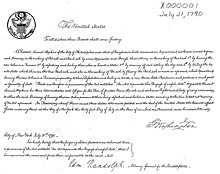
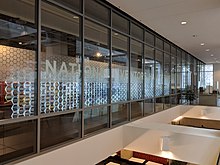
- On July 31, 1790, the first U.S. patent was issued to Samuel Hopkins for an improvement "in the making of Pot ash and Pearl ash by a new Apparatus and Process". This patent was signed by then-President George Washington.
- The X-Patents (the first 9,957 (approximately),[72] issued between 1790 and 1836) were destroyed by a fire; fewer than 3,000 of those have been recovered and re-issued with numbers that include an "X". The X generally appears at the end of the numbers hand-written on full-page patent images; however, in patent collections and for search purposes, the X is considered to be the patent type – analogous to the "D" of design patents – and appears at the beginning of the number. The X distinguishes the patents from those issued after the fire, which began again with patent number 1.
- Each year, the PTO issues over 150,000 patents to companies and individuals worldwide. As of December 2011[update], the PTO had granted 8,743,423 patents and received 16,020,302 applications.[73]
- On June 19, 2018, the 10 millionth U.S. patent was issued to Joseph Marron for invention of a "Coherent LADAR Using Intra-Pixel Quadrature Detection" to improve laser detection and ranging (LADAR).[74] The patent was the first to receive the newly redesigned patent cover. It was signed by then-President Donald Trump during a special ceremony at the Oval Office.[75]
- In February 2024, the USPTO issued a new guideline relating to obtaining a patent as per earlier recommendation by Biden's administration. The guideline states that; to obtain a patent, a real person, not AI, must have made a “significant contribution” to the invention and that only a human being can be named as an inventor on a patent.[76]
Patents issued under revised numbering scheme of the Patent Act of 1836 :
| Patent Number | Patent Title | Issue Date | Days Since Last Millionth Issue |
|---|---|---|---|
| 1[77] | Traction Wheels | July 13, 1836 | |
| 1,000,000[78] | Vehicle Tire | August 8, 1911 | 27,419 |
| 2,000,000[79] | Vehicle Wheel Construction | May 12, 1932 | 7,583 |
| 3,000,000[80] | Automatic Reading System | May 6, 1955 | 8,394 |
| 4,000,000[81] | Process for Recycling Asphalt-Aggregate Compositions | December 28, 1976 | 7,907 |
| 5,000,000[82] | Ethanol Production by Escherichia Coli Strains | March 19, 1991 | 5,194 |
| 6,000,000[83] | Extendible Method and Apparatus for Synchronizing Multiple Files on Two Different Computer Systems | December 7, 1999 | 3,185 |
| 7,000,000[84] | Polysaccharide Fibers | February 14, 2006 | 2,261 |
| 8,000,000[85] | Visual Prosthesis | August 16, 2011 | 2,009 |
| 9,000,000[86] | Windshield Washer Conditioner | April 7, 2015 | 1,330 |
| 10,000,000[87] | Coherent Ladar Using Intra-Pixel Quadrature Detection | June 19, 2018 | 1,169 |
| 11,000,000[88] | Repositioning Wires and Methods for Repositioning Prosthetic Heart Valve Devices within a Heart Chamber | May 11, 2021 | 1,057 |
| 12,000,000[89] | Labeled Nucleotide Analogs, Reaction Mixtures, and Methods and System for Sequencing | June 4, 2024 | 1,120 |
| Vertical bar chart data of United States Patent and Trademark Office between 1911 and 2024 |
 |
Trademarks
The USPTO examines applications for trademark registration, which can be filed under five different filing bases: use in commerce, intent to use, foreign application, foreign registration, or international registration.[90] If approved, the trademarks are registered on either the Principal Register or the Supplemental Register, depending upon whether the mark meets the appropriate distinctiveness criteria. This federal system governs goods and services distributed via interstate commerce, and operates alongside state level trademark registration systems.[91][92][93]
Trademark applications have grown substantially in recent years, jumping from 296,490 new applications in 2000,[94] to 345,000 new applications in 2014, to 458,103 new applications in 2018.[95] Recent growth has been driven partially by growing numbers of trademark applications originating in China; trademark applications from China have grown more than 12-fold since 2013, and in 2017, one in every nine trademark applications reviewed by the U.S. Trademark Office originated in China.[96]
Zdroj:https://en.wikipedia.org?pojem=USPTO
Text je dostupný za podmienok Creative Commons Attribution/Share-Alike License 3.0 Unported; prípadne za ďalších podmienok. Podrobnejšie informácie nájdete na stránke Podmienky použitia.
Antropológia
Aplikované vedy
Bibliometria
Dejiny vedy
Encyklopédie
Filozofia vedy
Forenzné vedy
Humanitné vedy
Knižničná veda
Kryogenika
Kryptológia
Kulturológia
Literárna veda
Medzidisciplinárne oblasti
Metódy kvantitatívnej analýzy
Metavedy
Metodika
Text je dostupný za podmienok Creative
Commons Attribution/Share-Alike License 3.0 Unported; prípadne za ďalších
podmienok.
Podrobnejšie informácie nájdete na stránke Podmienky
použitia.
www.astronomia.sk | www.biologia.sk | www.botanika.sk | www.dejiny.sk | www.economy.sk | www.elektrotechnika.sk | www.estetika.sk | www.farmakologia.sk | www.filozofia.sk | Fyzika | www.futurologia.sk | www.genetika.sk | www.chemia.sk | www.lingvistika.sk | www.politologia.sk | www.psychologia.sk | www.sexuologia.sk | www.sociologia.sk | www.veda.sk I www.zoologia.sk
